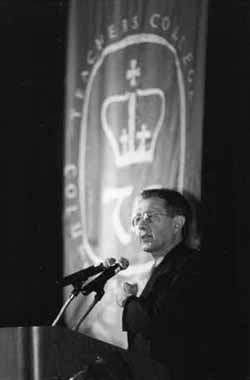Jonathan Kozol Presents Marx Lecture
Writer and educator Jonathan Kozol fought New York City traffic on a rainy October day to address a packed Horace Mann Auditorium as the Virginia and Leonard Marx Lecturer for 2002. After brief remarks by President Arthur Levine about the history of the Marx Lecture and the Marx professorships held by Professor Jeanne Brooks-Gunn and Professor Sharon Lynn Kagan. Brooks-Gunn introduced Kozol on behalf of both professors.
Calling Kozol the "most eloquent spokesperson for America's disenfranchised," she credited him with having the "incomparable ability to take abstract social problems and connect readers instantly" with those about whom he writes.
"Without the kind of work Jonathan does," she continued, "millions of people would not know what the lives of poor children are like."
Kozol, whose many publications depict his experiences of working with and getting to know some of the country's poorest people through schools, churches and homeless centers, greeted the audience by saying, "I feel close to teachers, especially those who work with little children. They do the best thing there is to do in life."
As someone intimately familiar with the hardships associated with teaching and learning in inner-city public schools, he noted emphatically, "Every Washington politician who talks about the failures of our inner-city teachers ought to be obliged to spend a day in an inner-city school."
He spoke of his early work as a teacher in Boston's segregated public schools in the early 1960s, about which his award-winning book Death at an Early Age was written. Since 1993, he has been working at schools in the South Bronx. Children there have the highest rate in the western world of chronic asthma. One-quarter of them have fathers in prison. In the schools where Kozol works, he said he does not see one white child-a phenomenon he calls "social apartheid."
Many people, he said, have criticized him for only writing about what he sees, and not referring to statistics. In his latest book, Ordinary Resurrections, he included the statistics with his personal experiences.
"Two years ago," he said, "in elementary and middle schools in the South Bronx neighborhood that I serve, there were 11,000 children-only 26 were white. That is a segregation rate of 99.8 percent." He added, "The public schools of New York City, like schools everywhere in the U.S., are segregated and outrageously unequal."
He added more statistics. When he wrote his last book, New York City was spending $8,000 per pupil for students in the South Bronx. In the white suburbs, schools get $12,000 per pupil, and in the wealthier areas, school districts get $18,000 per pupil for public education. Teachers in inner-city schools, he said, earn a median salary of about $40,000 less than the median salary of teachers in Scarsdale schools, who made about $80,000 per year.
"People agree with everything I say," Kozol continued. "They say, 'Yes, it is unfair they don't get as much per pupil as our children.' Then they say, 'Tell me one thing. Can you really solve this kind of problem by throwing money at it?' And I say, 'You mean, can you really buy your way to a better education? It seems to work for your children.'"
Kozol spoke of current efforts of inner-city schools to have teachers justify every moment in the classroom with a catalog number identifying what educational task that project or lesson is meeting. "A lot of schools are worried about playfulness," he noted, since it is not "on task."
"Some of the best things that ever happened to me were not on task," he said to an appreciative applause from the audience.
He sometimes has the opportunity to bring celebrities into the classes he works with. "Of all the grown-ups I brought with me, the one who meant the most to the children and teachers was a man every one of you would love to spend a whole day of your lives with-Mr. Rogers," he said.
Though Kozol was afraid some of the children might not recognize Mr. Rogers, one little boy went up to him and gave him a big hug, saying, "Welcome to my neighborhood."
The future that Kozol sees for the children he works with is less than promising. "By the time these kids grow up, they will have compliant voices and truncated aspirations. They will be market ready and still not be fully human."
He charged the educators in the audience to defend inner-city children against market-driven madness and, instead, to uphold a nobler tradition. He told them, in essence, "Be inventive, be subversive and be bold." And, in doing so, he was not asking anyone to do anything he has not already done himself.
Published Monday, Feb. 24, 2003
